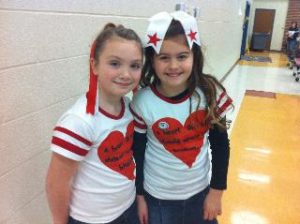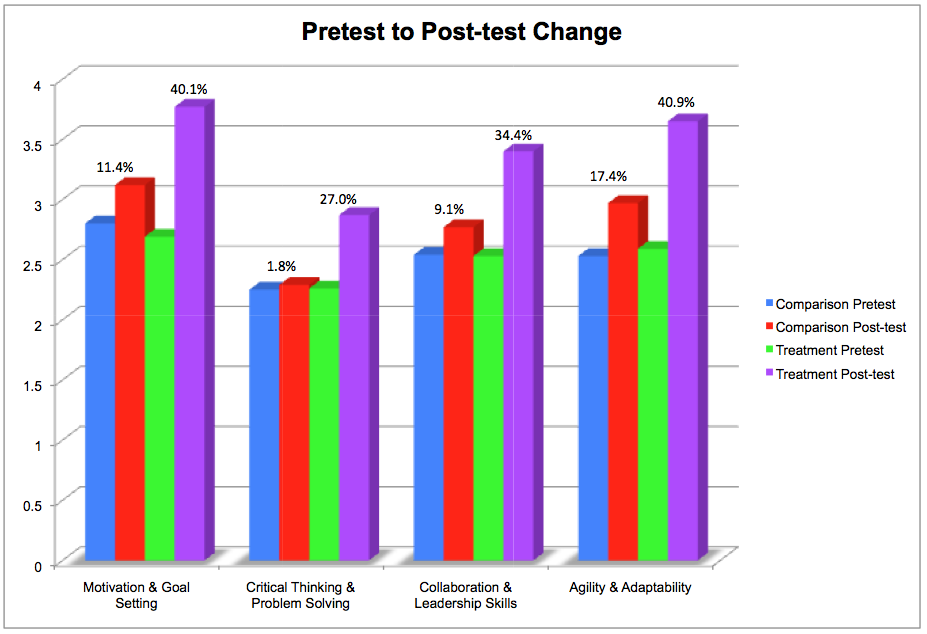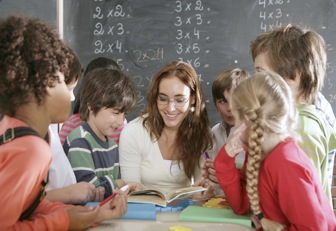This study examines the relationship between social-emotional instruction and academic competencies of motivation and goal setting, critical thinking and problem solving, collaboration and leadership, and agility and adaptability. The researcher embedded a social-emotional curriculum called Self-Science designed by Six Seconds in her third grade classroom during the 2010-2011 school year.
 Findings indicated increased motivation and goal setting, critical thinking and problem solving, collaboration and leadership skills, and agility and adaptability. Averaging improvements in all areas, students receiving Self-Science increased an average of 25.7% more than the comparison group. Qualitative data was also gathered to understand student perceptions. Thinking about potential benefits of an EQ curriculum such as Self-Science, one student wrote:
Findings indicated increased motivation and goal setting, critical thinking and problem solving, collaboration and leadership skills, and agility and adaptability. Averaging improvements in all areas, students receiving Self-Science increased an average of 25.7% more than the comparison group. Qualitative data was also gathered to understand student perceptions. Thinking about potential benefits of an EQ curriculum such as Self-Science, one student wrote:
“In third grade if we are learning self-science then in fourth grade there will be less bullies or even no bullies.”
Action Research: Exploring the Effects of a Social-Emotional Curriculum on the Academic Competencies and Self-Perception of Students in a Third-Grade Classroom
By Anna Kearney, MA
Following a cluster of teen suicides in an affluent suburb in Silicon Valley, California, community members began to question the academic pressures felt by students as young as elementary school in this consistently high-performing school district. In an effort to provide students with the emotional tools needed to alleviate this pressure, one K-5 elementary school began implementing a social emotional curriculum on a limited scale in 2010. As a participating member of this piloting team, one teacher-researcher examined the impact of the social-emotional curriculum Self-Science on the academic competencies of motivation and goal setting, critical thinking and problem solving, collaboration and leadership, and agility and adaptability.
The intervention, Self-Science, is designed by Six Seconds: The Emotional Intelligence Network. It focuses on teaching students how to make decisions, communicate and collaborate, and problem solve creatively while fostering emotional intelligence. The authors of the curriculum note that its lessons are not lectures, but experiential-based, student-centered, and designed to empower students (McCown, 2010). This curriculum is based on three main goals: to know yourself, to choose yourself, and to give yourself. Lessons focus on eight specific competency areas: enhancing emotional literacy, recognizing patterns of behavior, applying consequential thinking, navigating emotions, engaging intrinsic motivation, exercising optimism, increasing student capacity for empathy, and pursuing noble goals.
Based on the emerging body of research indicating that emotional intelligence is a predictor of classroom behavior and academic performance (Esturgó-Deu&Sala-Roca, 2010), the teacher-research began to question whether this particular social-emotional learning curriculum would have an impact on academic performance. Specifically, the teacher-researcher chose to examine the influence of the SEL program on the academic competencies of motivation and goal setting, critical thinking and problem solving, collaboration and leadership, and agility and adaptability. Additionally, the action research sought to gather student perceptions of the SEL program to aid in decisions regarding curriculum adoption.
Using a 40-item survey created by the teacher-researcher in conjunction with a university advisor in a pretest-posttest format, a 3rd grade classroom was compared to a control classroom at the same school. The control classroom was selected based on its similarity to the experimental classroom in terms of gender and race. Additionally, both teachers had similar years of experience.
For both groups, differences were noted within each academic competency area over the course of the school year, however the treatment group saw a significantly greater percentage increase than the comparison group. Within the competency area of motivation and goal setting, the comparison group shows an 11.4% increase in the group mean while the treatment group shows a 40.1% increase over the course of the year. Critical thinking and problem solving shows only a 1.8% increase for the comparison group and a 27.0% increase among the treatment group. For the competency area of collaboration and leadership skills, the comparison group increased by 9.1% while the treatment group increased by 34.4%. The greatest change for both groups was seen in the area of agility and adaptability, where the comparison group increased by 17.4% and the treatment group by 40.9%.

When analyzing the data for the competency area of motivation and goal setting, the survey items that saw the greatest change were “I like assignments that challenge me” with a 64.3% increase for the treatment group, compared to a 7.2% increase for the comparison group, and “I set goals for myself in school” with a 62.2% increase for the treatment group, compared to a 10.2% increase for the comparison group.
Within the competency area of critical thinking and problem solving, the largest differences between the treatment and comparison groups are in the items “I develop lots of good solutions to problems” with an increase of 1.78% in the comparison group and 34.09% in the treatment group, and “I can list reasons for and against an argument” with a decrease of 5.12% in the comparison group and an increase of 34.09% in the treatment group. Both of these are skills addressed in Self-Science.
The intervention appears to have been particularly influential on the competency area of collaboration and leadership, as indicated by the item “I am a leader in my class” which saw a 73.8% increase in the treatment group, whereas the comparison group only saw a 2.56% increase. Within the Self-Science curriculum, a great deal of attention is given to the pursuit of “give yourself.” Towards this goal, students learn how to initiate change and persuade others to join their cause through clear, concise reasoning. These lessons give students opportunities to practice their leadership skills and appear to have been quite effective in students’ self-image as leaders as evidenced by this survey response.
The final competency area, agility and adaptability, saw increases on each item for both the treatment and comparison groups. However, the percentage of increase is significantly higher for the treatment group, particularly on the item “I stay on task when doing my schoolwork” which saw a 51.92% increase for the treatment group and a 14.47% increase for the comparison group. The Self-Science curriculum does not focus explicitly on this skill, and the connection between the intervention and this growth is not immediately clear, however the answer may lie in the information garnered from the focus groups.
 Following the intervention, the treatment group participated in focus groups consisting of 5-6 students. The groups were asked to define the term self-science, describe positive student behavior, and to indicate how Self-Science influenced them in the classroom setting. The teacher-researcher selected these questions in order to evaluate the effectiveness of the curriculum and aid in the adoption decision. Notable trends included the idea that Self-Science teaches students to control their emotions. As one third grader put it, Self-Science is about how “you build yourself up to a certain point where you know more about yourself and what you are feeling and why you are feeling it.” When asked to describe a good student, only three of the responses were related to study skills or intellectual ability while nine of them discussed social-emotional competencies. Students also noted how Self-Science helped them to do well in school as they were able to concentrate on schoolwork instead of playground conflicts, which may explain why students in this group felt more able to stay on task on the post-survey than those in the control group.
Following the intervention, the treatment group participated in focus groups consisting of 5-6 students. The groups were asked to define the term self-science, describe positive student behavior, and to indicate how Self-Science influenced them in the classroom setting. The teacher-researcher selected these questions in order to evaluate the effectiveness of the curriculum and aid in the adoption decision. Notable trends included the idea that Self-Science teaches students to control their emotions. As one third grader put it, Self-Science is about how “you build yourself up to a certain point where you know more about yourself and what you are feeling and why you are feeling it.” When asked to describe a good student, only three of the responses were related to study skills or intellectual ability while nine of them discussed social-emotional competencies. Students also noted how Self-Science helped them to do well in school as they were able to concentrate on schoolwork instead of playground conflicts, which may explain why students in this group felt more able to stay on task on the post-survey than those in the control group.
As one student put it:
I think it helps us in school because we usually have fights and stuff and it helps us to not get into fights. Most of the fights happen outside but when you come into the classroom you’re still fuming about it, like ‘I’m never going to talk to her again’ or something like that. And then you aren’t actually listening to the teacher. But with self-science you aren’t getting into fights as often so you can listen more.

The primary purpose of this action research was to explore the impact of a social-emotional curriculum on student academic competencies. Based on the data gathered from the pretest and post-test surveys, there is evidence of a link between EI and academic competencies. These observations are consistent with those found by Durlak et al. (2011) in their meta-analysis of SEL programs and give further empirical evidence of the positive effects of social-emotional learning.
Secondarily, this action research sought to gather information about student perceptions of the SEL curriculum Self-Science to aid in the adoption decision. The focus group responses indicated an understanding on the part of students that emotions play a role in the ability to focus on schoolwork and that a successful student is not just somebody with high academic intelligence, but somebody with high emotional intelligence who is able to monitor his or her own behavior. These results indicate that students also perceived a link between the SEL curriculum and being a successful student.
Based on the findings of this action research, this particular elementary school site has chosen to implement Self-Science on a wider scale. As a result, students will experience the SEL curriculum over the course of several years, potentially having a more lasting effect on both EI and academic competencies. With intense pressures on our schools to raise academic achievement levels, the positive effects of social-emotional instruction on academic competencies warrant more attention from educators everywhere.
References
Durlak, J. A., Weissberg, R. P., Dymnicki, A. B., Taylor, R. D., &Schellinger, K. B. (2011). The impact of enhancing students’ social and emotional learning: A meta-analysis of school-based universal interventions. Child Development, 82(1), 405-432.doi:10.1111/j.1467-8624.2010.01564.x
Esturgó-Deu, M.E., & Sala-Roca, J. (2010). Disruptive behavior of students in primary education and emotional intelligence.Teaching and Teacher Education, 26, 830-837.
McCown, K., Jensen, A., Freedman, J., & Rideout, M. (2010). Self-Science: Getting started with social emotional learning. San Francisco, CA: Six Seconds Emotional Intelligence Press.
- Creating Connection in Higher Education - May 29, 2018
- Research: Growing an Emotionally Intelligent School - April 17, 2018
- Studying EQ in a Rural Appalachian Highschool - June 17, 2016

Adaptability which is a key problem in young children also shown remarkably increased in treatment group. I found the data of comparison and treatment group is very overwhelming. The students of treatment group have developed a very high value in motivation and goal setting is very interesting. The problem solving abilities have also increased interestingly although the average is 25% increase. Introducing self science in building emotional intelligence is very interesting for me. I strongly believe in self science but never know about the data…. The presented data here was the complete and impressive I am speech less…
Read this article introducing self science in building emotional intelligence is very interesting. I found the data of comparison and treatment group is very overwhelming. The students of treatment group have developed a very high value in motivation and goal setting is very interesting. The problem solving abilities have also increased interestingly although the average is 25% increase. I strongly believe in self science but never know about the data….
This article was very informative and quiet interactive Giving a high value and educating teachers and students
Reading this article I see hope and change. This work is very grateful and valuable. It has the right map to students as well as teachers.
The impact of this work is huge in my personal development and I do believe anyone reading this article will be definitely impacted. Teachers and students will have an interest when reading this article. Thanks for the good things you do.
I read this article with a great deal of interest. It certainly bespeaks of an action reserarch project that has such great potential in addressing many aspects of students becoming leaders and serving as role models for others. The curriculum appears to be one that should be incorporated in the very early years with a logitudinal study that can more effectively assess lasting desired outcomes.
HI Brenda: I agree that this sort of research has great potential and that a longitudinal study would be of great value. Six Seconds supports researchers who wish to use our assessment tools, so I hope this will be of interest to many teachers and educators out there.
This is an awesome example of how our interaction,direction,disapline and nurturing the essence of personal knowledge will equate into a community (ie. school= community at large= state=national=international) That these children as emotionally intellegent beyound the norm by seem to have a capacity and there is a leadership quality to the child that does follow a more regimented,demanding and still a very positive enviornment . The key or one of them seems to be very clear as a former elite level coach,I saw a diect correlation between the truly elite(OLYMPIAN) as opposed to those girls that were just well prepared .The most obvious was the emotionally intelligent were always the ones that were most stabile and reached the highest level in both sport and community. Eric Singer change is the inner most knowledge of SELF that is a gift to others.
Awesome! Anna – what a wonderful project, and your finding is incredibly compelling. I hope this inspires thousands of teachers to do this kind of assessment themselves.
I think everyone reading should know: Anna’s project was so compelling to the other teachers and administrators in the school that now they’re committed to making this a “pillar” of the school’s approach.
Change starts on the inside.
🙂
These findings are a great support for my personal observations in my coaching of children up to the Olympic level. All indications of the intense emotional as well as intellectual developement at our national training center in Frankfurt/main Germany ,would totally support these findings. We did no formal testing except we did see a remarkable developement in the emotional intelligence,the girls ability to socialize,and still show very strong characteristics of individualism,creativity and excellance in achademic skills. The stronger the child would be challanged,physically the greater the intensity of her creative input,the strict organization,time management and the effect of the team building gave a very strong ,emotionally intelligent as well as intellectually developed individual
.I think the effect of a parent/child relationship as opposed to the friend/child type of interaction is also a large contributing factor. Theexpected and instinctive respect that is nurtured with the parent/child propelled the athletes much faster than the friend/child interaction at the coaching levels. Which also would show the breakdown of respect does influence the emotional intelligence. Hence the child will tend to bullie and show more personally aggressive,and less sensitiity to the group as well as personal commitment to intellectual developement.The data is a huge step at development of the well balance and emotionally intellegent person.The effects on the society in generat will show up as a strong united community . Think about the effects on world levels,gives us a hope for the future. Without the emotionally as well as intellectually intellegence we have a world without creativity,peace and harmony. Both areas are showing up in schools today and I must say it is frightening what we have allowed to be created,undisciplined,aggressive and very “parent” DEVOID children,add the parent into the equasion and subtract the “friend”/child parenting attitude and interject the Parent/child relatioships with the specific goals . These being learning the basis of f the word NO which will redirect the energy back to growth and strongly motivated children. Structure in that developement,time management,personal knowledge(if you don’t know your essence) Through to stressful,team ,supported, in physiological ,broken out into geat people. Creative,disaplined,happy plus the factor was most obvious respect for authority,giving the children stability in all phases of personal developement….the solid athelete ,student, champion for themselves.
Er ic Singer